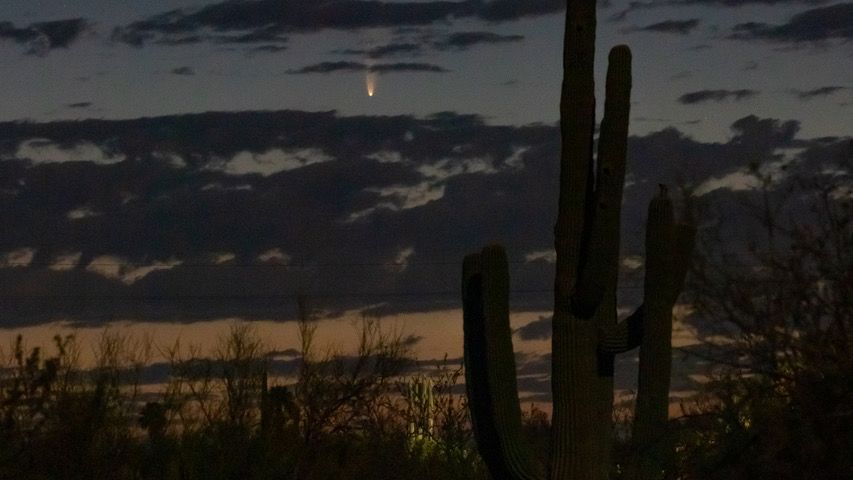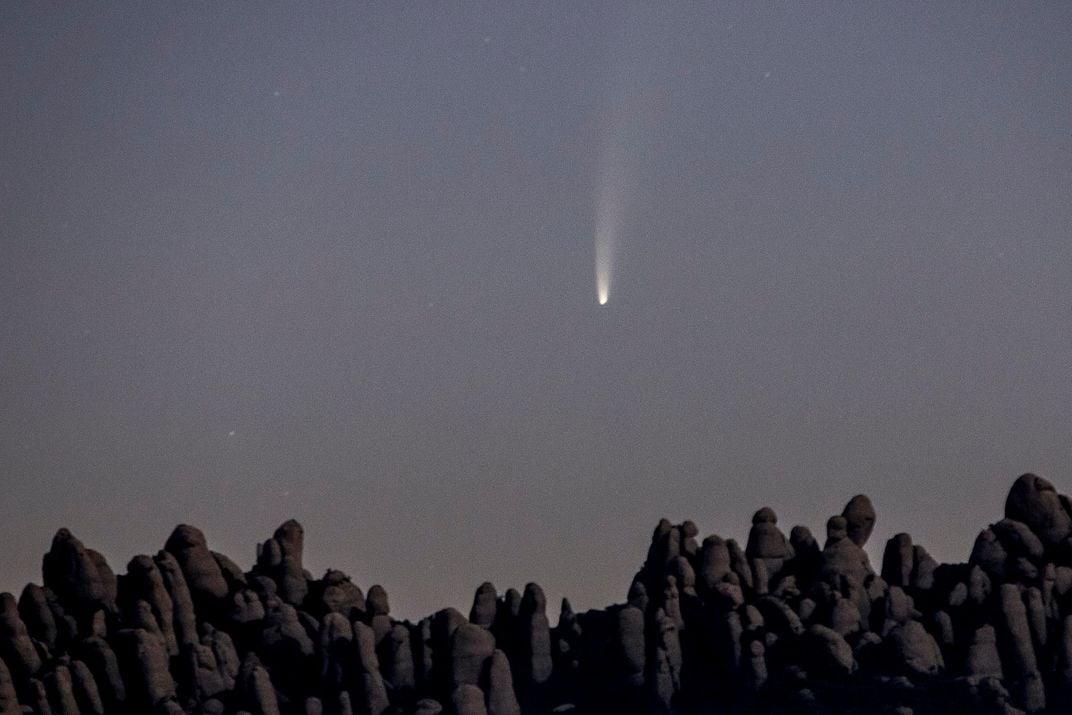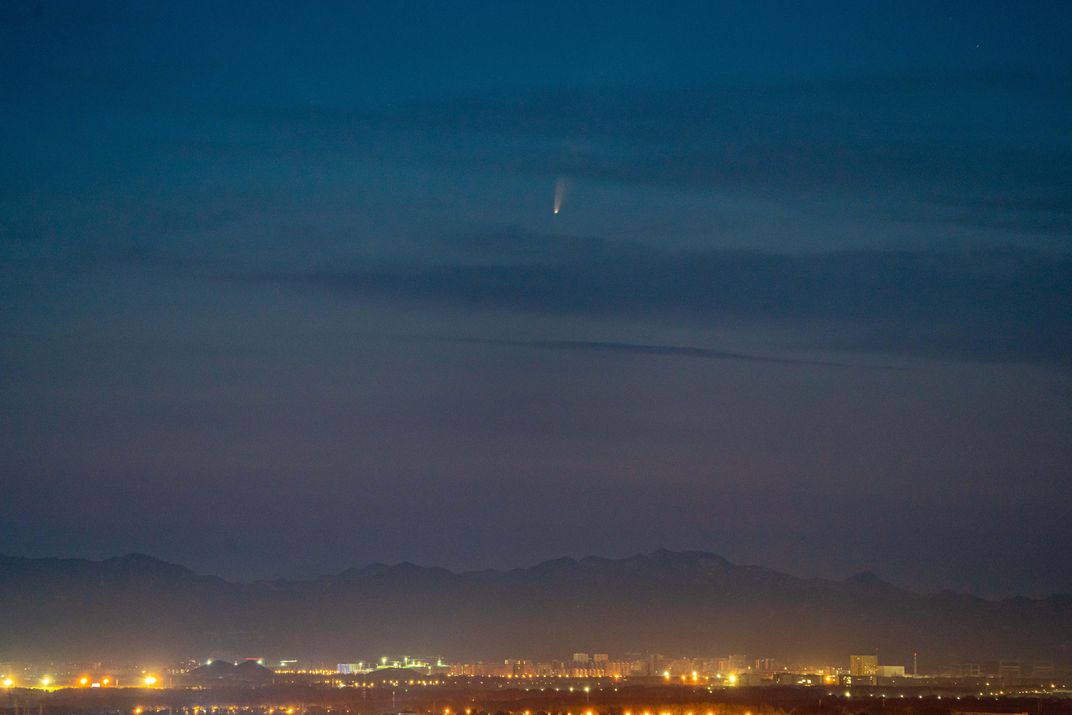How to Watch Comet Neowise’s Spectacular Show
Until mid-August, the comet will be bright enough to spot with the naked eye
/https://tf-cmsv2-smithsonianmag-media.s3.amazonaws.com/filer/54/7e/547e87ed-7e2a-4191-b77c-bebc6bf183a6/comet_neowise_nasa_bill_dunford.jpeg)
A giant icy snowball is currently hurtling past Earth and putting on a spectacular light show—but only for a limited time. Comet C/2020 F3 NEOWISE, the interstellar object responsible for this “natural fireworks display,” will peter out in mid-August, as it speeds away from our sun and back into the outer reaches of our solar system, according to a NASA statement.
The comet is easy to spot with the naked eye if you avoid city lights, reports Matthew Cappucci for the Washington Post. On July 11, viewers across the Northern Hemisphere will be able to spot the comet and its glowing tail right before dawn—between 4 a.m. and 5 a.m. Eastern time will be the sweet spot. The comet will appear to the east-northeast of the sky and close to the horizon, so it’s important to find a dark spot with an unobstructed view of the sky, NASA ambassador Tony Rice tells the Post.
Beginning sometime between July 12 and 15, the comet will start to appear in the evenings. It will pop up just above the horizon after sundown and stay visible each night through mid-August.
From mid-July to mid-August, look to the west-northwest after sunset—between the stars of the Big Dipper—and keep an eye out for a fuzzy, bright object with a long orange tail, reports Dan Falk for National Geographic. Scientists recommend using binoculars or a telescope to get a clearer view, writes Eddie Irizarry for EarthSky. Up close, you might even be able to spot the comet’s forked tail. One part of the comet’s spliced tail is made primarily of gases, while the other is made up of dust, per the Post.
NEOWISE will move closest to Earth on July 22, flying just 64 million miles above the planet’s surface, according to EarthSky.
Scientists from NASA say that NEOWISE might be the brightest comet to visit Earth in more than a decade, per National Geographic. The most impressive comets in recent memory were Comet Hale-Bopp in 1997, and Comet McNaught in 2007, which lit up skies in the Southern Hemisphere.
Last night's fireworks, for real. Because Science. #NEOWISE #comet pic.twitter.com/IKcJ1wLFAl
— Bob Behnken (@AstroBehnken) July 5, 2020
NEOWISE flew just inside Mercury’s orbit on July 3, passing very close to the boiling-hot surface of the sun. As it flew by, the sun’s heat “cooked” some of the comet’s icy layers, causing parts of its surface to fall behind the comet in a trail of debris. Now, the comet is moving past Earth as it travels on its elliptical orbit further into the solar system, with a long glowing trail of dust and gases in tow.
Scientists have been taking advantage of NEOWISE’s trip to learn more about its surface composition, according to the NASA statement. “From its infrared signature, we can tell that it is about 5 kilometers [3 miles] across, and by combining the infrared data with visible-light images, we can tell that the comet's nucleus is covered with sooty, dark particles left over from its formation near the birth of our solar system 4.6 billion years ago,” says Joseph Masiero, the scientist leading investigations of NEOWISE at NASA’s Jet Propulsion Laboratory.
NEOWISE gets its name from the Near-Earth Object Wide-Field Infrared Survey Explorer (NEOWISE), the NASA space telescope that scientists used when they first noticed the comet on March 27.
“In its discovery images, Comet NEOWISE appeared as a glowing, fuzzy dot moving across the sky even when it was still pretty far away,” describes Amy Mainzer, a scientist at the University of Arizona who’s on the team of people studying NEOWISE, in the NASA statement. “As soon as we saw how close it would come to the Sun, we had hopes that it would put on a good show.”
/https://tf-cmsv2-smithsonianmag-media.s3.amazonaws.com/accounts/headshot/nora.png)



/https://tf-cmsv2-smithsonianmag-media.s3.amazonaws.com/accounts/headshot/nora.png)